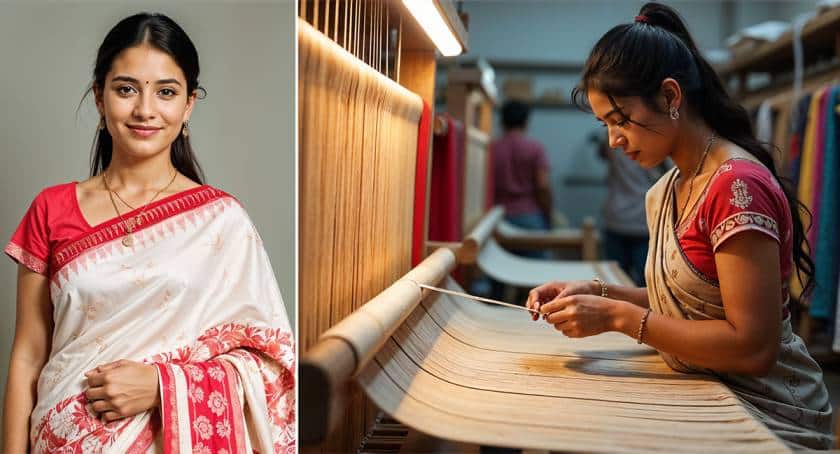Jala Technique: Weaving in Odisha
Odisha, a land of rich history, culture, and artistic excellence, is renowned for its intricate handloom weaving traditions. Among the many weaving techniques practiced in the state, the Jala technique stands out as one of the most complex and beautiful methods of fabric creation. Skilled artisans have passed down this ancient and sophisticated weaving style through generations, demonstrating exceptional artistry. Despite the challenges posed by modernization and mechanization, this remarkable art form continues to symbolize Odisha’s textile legacy. To highlight the relevance of the Jala weaving technique and the necessity of maintaining this ancient custom, we shall examine its history, method, significance, and current state in Odisha.
Tracing the Historical Significance
The Jala technique has its roots in Odisha’s age-old textile heritage, dating back several centuries. Historically, royalty and aristocrats patronized this weaving method, desiring intricately designed fabrics for ceremonial and everyday use. The technique flourished under the patronage of local kings, especially during the rule of the Gajapati dynasty, when Odisha was a significant center for textile production. Weavers of that era created luxurious garments for the royal families, temple deities, and wealthy patrons, reinforcing the significance of this intricate craft. Odisha’s cultural and religious practices also influenced the Jala method, as temple architecture, mythological stories, and nature inspired many motifs and patterns.
Odisha’s skilled artisans developed and refined the Jala method, making it an integral part of the state’s rich textile tradition. The weavers—also referred to as “Bhulia” or “Meher” artisans—were instrumental in maintaining and transferring this unique ability over generations. Despite stiff competition from power looms and changing consumer preferences, these artisans have continued to uphold the legacy of handloom weaving, ensuring that the Jala technique remains a treasured aspect of Odisha’s textile industry.
Deciphering the Intricacies of Jala Weaving
The Jala technique is a highly sophisticated weaving method that involves an additional set of warp threads manipulated through a supplementary weft. This technique allows weavers to create intricate motifs and patterns directly on the loom without relying on external templates or printed designs. The method demands immense precision and patience as artisans manually craft the motifs using a lattice-like mechanism known as the Jala.
Unlike modern Jacquard weaving, which relies on pre-programmed punched cards, artisans create the Jala technique entirely by hand. Weavers create each pattern by adjusting the Jala framework, ensuring the motifs appear seamlessly on the fabric. This process is highly time-consuming and requires extensive experience, as any mistake in thread placement can affect the overall design. Artisans mainly use the technique to produce silk and cotton fabrics, often adorning them with elaborate patterns highlighting Odisha’s artistic traditions.
Key Elements of the Jala Weaving Process
Several key components make the Jala technique unique and intricate:
- Jala (Lattice Framework): The Jala is a specialized framework used to guide the placement of extra warp threads, allowing weavers to create elaborate designs.
- Extra Warp and Weft Threads: These additional threads form complex motifs and enhance the fabric’s texture.
- Tie-and-Dye Process: The Jala technique often incorporates Ikat or Bandha dyeing methods, where the threads are tied and dyed before weaving to produce mesmerizing color patterns.
- Manual Dexterity: Since they use no pre-drawn templates, weavers rely on their expertise and experience to form the designs, making each fabric a unique masterpiece.
Step-by-Step Weaving Process
The Jala weaving technique follows a careful process that involves multiple stages:
- Yarn Preparation: Fine-quality silk or cotton threads are selected and dyed using natural or synthetic colors. Artisans prefer natural dyes because they are eco-friendly and long-lasting.
- Warp and Weft Setup: Artisans arrange the warp threads on the loom and prepare the weft threads for insertion. This setup determines the fabric’s final texture and density.
- Design Creation with Jala Framework: The lattice framework (Jala) manipulates the extra warp threads, forming patterns and motifs with high precision.
- Weaving and Weft Insertion: Artisans carefully insert the weft threads, ensuring proper alignment with the warp. The artisan carefully interlaces the threads to maintain the design’s accuracy.
- Final Finishing: After weaving the fabric, artisans apply finishing touches like washing, stretching, and ironing to enhance its luster and durability.
Symbolic Motifs and Artistic Expressions
Artisans craft the motifs using the Jala technique, drawing inspiration from Odisha’s rich cultural heritage and mythology. Some of the most common motifs include:
- Floral Designs: Lotus, jasmine, and marigold patterns symbolize purity and prosperity.
- Animal and Bird Figures: Elephants, peacocks, and parrots represent strength, grace, and beauty.
- Geometric Patterns: Intricate lattice and diamond-shaped motifs showcase mathematical precision in design.
- Temple and Chariot Designs: Inspired by Odisha’s iconic architectural marvels like the Jagannath Temple and Rath Yatra chariots.
These motifs add aesthetic value to the fabric and narrate stories of Odisha’s glorious past, making each textile visually represent the state’s artistic brilliance.
Significance of Jala Weaving in Odisha’s Textile Industry
The Jala technique holds immense significance in Odisha’s textile industry for several reasons:
- Cultural Preservation: The Jala method embodies Odisha’s artistic legacy and traditional knowledge passed down through generations of skilled weavers.
- Economic Contribution: The handloom sector provides employment opportunities to thousands of artisans, supporting local economies and sustainable livelihoods.
- Artistic Excellence: The intricate craftsmanship involved in Jala weaving highlights Odisha’s artisans’ high skill and creativity.
- Sustainable Fashion: The technique promotes eco-friendly weaving practices, using natural dyes and handwoven methods with minimal environmental impact.
Final Thoughts
Odisha’s Jala technique is evidence of its weavers’ skill, patience, and artistry. As one of the most intricate and labor-intensive weaving methods, it reflects the rich cultural tapestry of Odisha’s heritage. Despite modern challenges, efforts to preserve and promote this unique craft continue, ensuring that the Jala technique remains a celebrated aspect of India’s handloom legacy. Supporting handwoven textiles and recognizing the efforts of artisans will play a crucial role in keeping this traditional art alive for future generations.


